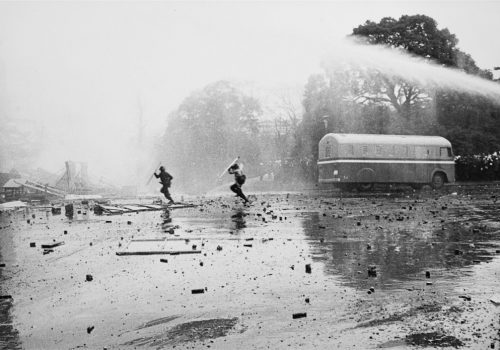A/Fixed is a biannual journal published in English in newspaper format. Created in Spring 2017 at the initiative of the journalist Tsuyoshi Ito, it is co-edited by Project Basho, a photography association based in Philadelphia, and by the Benrido Collotype Atelier in Kyoto. Its first issue, Provoke Generation: Japanese Photography 60s–70s, recontextualizes the Japanese movement and its “language to come” (Takuma Nakahira), positioning postwar Japan as a key player in the world of photography.
Already on the opening pages, the British photography curator Simon Baker (Tate Modern) declares that, by its scope and its lasting influence, Provoke exceeds the limited awareness the Western public has of Japanese photography of that period. We tend to equate Provoke with its best-known photographers: Daido Moriyama and Takuma Nakahira are two shining examples. But we often forget that the Japanese magazine was “avant-garde in the full sense, … an attempt not only to make images, but to give a sense of the perspective from which the person making the images is seeing the world.” Miyako Ishiuchi, Takuma Nakahira, Daido Moriyama, Yutaku Takanashi, Kazuo Kitai, Hitomi Watanabe… all thought of photography as an “expressive, subjective, and kind of destabilizing and quite radical medium.” They utilized, tinkered with, and exploited the visual power of photography.
Provoke was founded in 1968 by the critic Kōji Taki, the photographers Takuma Nakahira and Yutaku Takanashi, and the writer Takahiko Okada. The magazine had only three issues, but through their extraordinary density, it introduced, first to Japan, then to the rest of the world, a new photographic language. This language to come was constructed in the sociopolitical context in Japan. In 1969, Japan was marked by a series of protests against the presence of US military bases on its territory, against the American war in Vietnam, and against the construction of the country’s largest airport in what was then farmland. The decade gave rise to a strong utopian brand of activism. Paradoxically, the decade was also marked by a turning of a majority of the Japanese population toward American culture. Japan massively adopted Western lifestyles, with consumerism and economic success becoming the benchmarks of self-realization and social success. Japanese youth became the focus of that ambivalence. They were influenced by American abstract avant-gardes, music and film counterculture, the Beatnik lifestyle, and they adopted a consumerist outlook, even while rejecting the presence of the American military on Japanese soil.
The first issue of A/Fixed features a series of stories allowing readers to reconstruct the climate of this eventful decade. Thus, Pete Duval, the journal’s editor, retraces Provoke photographers’ footsteps. He visits Golden Gai, the district where Daido Moriyama took the bulk of his photographs. Bedecked with multicolor banners, narrow spiraling streets are dark, as if made for gritty nights. The district has now become touristy, but Pete Duval manages to uncover its soul well and alive in certain locations. We are surprised to discover a poorly lit pedestrian bar populated by regulars. Upstairs, Daido Moriyama had an “office,” preserved intact by the bar owner.
The journalist also offers readers a glimpse into the Benrido Atelier which, for several decades, has been making among the finest collotype prints in the world. Pete Duval reminds us that Provoke was also a photographic adventure based on the quality of images and prints. This Japanese aesthetic heritage was made “manifest in the photobook.”
Hideko Ono’s interview with the photographer and filmmaker André Principe—most recently author of the documentary film Traces of a Diary—captures the importance of the diaristic approach: photographing one’s street, one’s world, one’s intimates day after day, training one’s eye through daily practice the way a craftsman works his material with his fingers.
In addition to his interview with the British photography curator Simon Baker, Tsuyoshi Ito, the founder and managing editor of A/Fixed, also talks with Kazuo Katai. As a student at Nihon University, the photographer got to know and photographed some of the student protesters involved in the so-called “Barricade Strike,” a series of demonstrations, protests, and sit-ins at Japanese universities in 1968. Next, Kazuo Kitai covered the resistance of the farmers from Sanrizuka, a village threatened by the construction of the Narita International Airport. The village has now been destroyed, following several years of struggle. Playing a similar role, the photographer Hitomi Watanabe was one of only a handful of artists to document the life of the All-Campus Joint Struggle League (aka Zenkyoto) at Tokyo University. Her photographs, as well as her testimony, tell the story of the life of the group from an insider’s point of view, through to its radicalization as a citizen, nearly anarchic movement.
The guiding principle of the journal seems to be to carry on the philosophy developed by the photographer Takuma Nakahira in his book For a Language to Come (1970). Nakahira wrote that freedom is conditioned by our ignorance about the world. “…in reality, what do we know about the world? Don’t we just believe that we know something about it? If this is the case, there is no liberty without ignorance.” The approach adopted by A/Fixed revives the everyday curiosity of these photographers in the context of the new Japan and its ambivalence, of the youth culture fashioned by incoming cultures and its resistance to heritage, of the outside world, from the pits of capital cities to the heart of political activism. A/Fixed makes it possible for us to (re)discover the language to come, never formally structured, but rather nourished over decades by productive exchange and experimentation.
Arthur Dayras
Arthur Dayras is a writer specializing in photography. He lives and works in Paris.
A/Fixed is available for purchase online:
















